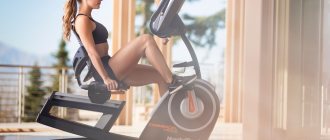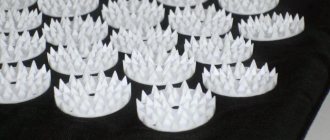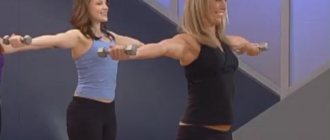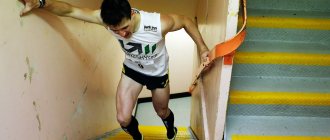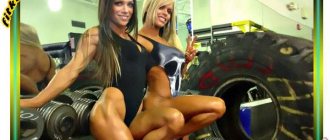Aerobic or cardio exercises tone not only the muscles, but also all systems of the body. Most of them involve stress on the knees and ankles, which is not suitable for people with problem joints.
But there is a machine that allows you to do aerobic training without impact on your legs. And this is a rowing machine that has virtually no contraindications.
Rowing machine: general information
A rowing machine, unlike a treadmill, ellipsoid, stepper and exercise bike, actively involves the upper and lower body in the work, but using the knee joints in a gentle manner. The simulator is one of the safest and is suitable for rehabilitation exercise after illness and injury.
Why do you need a rowing machine?
The rowing machine imitates the movements of rowers, which allows you to intensively work out the muscles of the back and shoulder girdle, as well as keep the muscles of the lower body toned.
According to the specific load, a rowing machine is more suitable for men than women, as it allows you to pump up your upper body well, using your legs and buttocks intensively, but not in a targeted manner. But for women it will also be useful for strengthening the muscles of the arms, back and abs, as well as keeping the legs and buttocks in good shape.
Pros of a rowing machine:
- Involving 80 to 95% of the body's muscles, which allows you to keep your body in shape at home.
- Improving blood circulation and strengthening the work of the heart muscle. Engaging a large number of muscles requires intense blood supply, which makes the heart work faster and more powerfully.
- Supplying the body with oxygen, which makes a person more alert and energetic.
- High calorie consumption. According to Harvard Health Publication, a man of average weight (80-85 kg) burns more than 350 kcal in half an hour of exercise, which is more than in 30 minutes of running on a treadmill.
- Increase in overall body strength. Rowing is not the easiest sport, as you have to work intensively with your whole body, using your legs. Regular exercise on a rowing machine strengthens the muscles of your back, arms, shoulders and abs, and also makes your legs stronger.
- Increased endurance. Exercises on a rowing machine strengthen and develop the heart muscle, normalize the functioning of the circulatory system, which improves the body's endurance.
- Acceleration of metabolism by strengthening muscles, reducing the percentage of adipose tissue and stimulating blood circulation and lymph flow.
- Reduced stress on joints, which reduces the possibility of injury. Due to its low risk of injury, the simulator is used in rehabilitation centers for recovery after illnesses and operations. It is also useful for obese people for whom other types of cardio training are contraindicated.
- The ability to pump up your upper and lower body at the same time, which is impossible with other cardio equipment.
- Versatility. The rowing machine is suitable for various purposes: losing weight, keeping fit, strengthening muscles and the cardiovascular system, rehabilitation and regular physical activity at home.
Cons of a rowing machine:
- Reduced load on the legs compared to other cardio equipment.
- Monotonous training, since during rowing you can only perform a certain range of movements.
- A combination of strength and cardio exercise, which is not suitable for those who are looking exclusively for an aerobic exercise machine.
- The need for complete concentration on movements, which makes it impossible to watch TV programs or movies during home exercises.
- Large dimensions of the simulator and its high cost.
Contraindications
Thanks to good body support during training and the most natural range of movements, the rowing machine is considered the safest cardio equipment.
But some contraindications still exist. You should familiarize yourself with them when planning to purchase an expensive exercise machine for your home.
- Arterial hypertension - a tendency to high blood pressure prohibits training on all types of cardio equipment.
- Radiculitis, osteochondrosis and severe scoliosis - problems with the spine can be a contraindication for rowing. But in mild forms of these diseases, rowing, on the contrary, is an indication, as it strengthens the muscular frame and develops the spine.
- Diseases of internal organs - intense exercise can cause pain, so it is not recommended.
- Colds, fever, women's periodic pain - exercise can increase fever and pain, so you should refrain from rowing during an acute period of illness or at the beginning of the cycle.
- Injuries in the initial stage - stretching of the back, muscles of the shoulders and forearms will prevent you from performing the exercises correctly, which means that the training will not be effective and will aggravate the situation.
The presence of a small number of general contraindications and the absence of specific ones suggests that the rowing machine is a good option for home cardio training, suitable for the vast majority of users.
3 reasons to buy a rowing machine
- Rowing exercises involve all muscle groups. The load on the body occurs in the following proportion: 60% on the bottom and 40% on the top, contrary to common misconceptions that the machine only trains the body and arms. During rowing movements, the back, chest, arms, shoulders, abs, as well as the muscles of the thighs and calves are actively worked.
- Energy consumption is up to 8 kcal per minute, which is more than when jogging on a track and in open areas. Due to its high energy consumption, a rowing machine is great for losing weight at home.
- Accelerates metabolism and quickly gets into shape compared to other aerobic exercise equipment. Unlike a stepper, elliptical or treadmill, a rowing machine provides a forceful load on the muscles, increasing their strength and shaping the relief. As a result, you get two bonuses: pumping up your body and improving your health.
After House of Cards, the popularity of rowing machines in the world has increased. The main character Frank Underwood used this exercise machine to stay in shape at home. And if earlier movie heroes trained mainly on treadmills, then the appearance of a rowing machine on the screens instantly attracted the attention of the public and the popularity of rowing machines grew exponentially.
Improvement of the cardiovascular system
Like other cardio exercises, rowing forces the heart to pump blood through muscle mass, providing it with energy (oxygen), nutrients, and removing waste products (carbon dioxide and lactic acid). However, rowing has a much greater impact on the described processes, which makes training more effective. The fact is that rowing machines use more muscles.
(according to various sources from 80% to 95%) than on other cardio equipment. More muscles require more energy, which means more blood circulation and heart function. Dr. Levine's work with NASA demonstrates that 30 minutes of rowing can be as effective as 90 minutes of cycling.
In addition, given that the human body is amazingly efficient at adapting to different loads, it is simply useful to vary the load for training. Get off the treadmill, get on the bike, then onto the rowing machine.
Rowing machine for weight loss
Running, aerobics and cardio exercises are considered an effective way to lose weight, as they are superior to strength training in terms of energy consumption. But the combination of strength training and cardio significantly speeds up this process. The rowing machine provides full aerobic and anaerobic exercise (depending on the strength of the resistance), which allows you not only to lose weight, but also to strengthen the muscles of the whole body.
Working muscles on a rowing machine
Rowing machine workouts work the entire body, evenly strengthening major muscle groups. Let's see which muscles work the most intensely:
- latissimus, rectus, rhomboid and trapezius dorsi muscles
- pectoralis major muscles
- shoulder deltoids
- triceps and biceps arms
- forearm muscles
- press
- quadriceps thighs
- calf muscles of the legs
The back, chest and shoulder girdle are used to the maximum, which is important for men. The load on the legs is comparable to working on a leg press machine, which will appeal to women who want to get beautiful thighs and calves.
Correct rowing technique
It is impossible to work on a rowing machine by inertia, since concentration is required on every movement. Follow these instructions to develop proper rowing technique:
- In the initial position, the legs are bent and rest against the base of the machine, the arms are extended and firmly hold the handle. The back is straight, the body leans forward slightly, the shoulders are turned inward.
- From the starting position, push with your legs while simultaneously pulling the handle (rowing arms) towards your body.
- When your legs are fully straightened, pull the handle even closer to your chest, working not with your arms, but with your back. In the final phase of the movement, the body will be slightly tilted back.
- Return to the starting position by bending your knees.
There are many rowing machine training programs available today, but only by knowing the correct rowing technique can you perform them effectively.
Center Pull Rowing Machine:
Rowing machine with Nordic row:
Is the rowing machine effective for losing weight?
Despite the fact that the rowing machine is classified as a cardio machine, its load is equivalent to anaerobic, especially if you increase the resistance force. By performing complex multi-joint movements on a rowing machine, you work every significant muscle group, resulting in a large calorie burn during your workout.
The combination of aerobic and anaerobic exercise, active involvement of the upper and lower body, high calorie consumption - all this turns the rowing machine into an effective option for losing weight at home. And an additional factor: people with significant excess weight can work on the machine, which is not always possible on a treadmill or ellipsoid.
Rowing machine: who is it suitable for?
It is generally accepted that the rowing machine is only suitable for men, as it involves more of the upper body rather than the lower body. But it has been proven that the load on the simulator is distributed almost evenly. Therefore, it is useful to do absolutely everything on it, regardless of gender, age and physique.
Rowing machine is suitable:
- those who want to lose weight, as it allows you to burn from 400 to 800 kcal per workout
- those recovering from serious illnesses and injuries
- people who are overweight and have problem joints
- for those who want to strengthen the cardiovascular system
- people who do jogging and other cardio exercises to stay fit during the off-season
- for everyone who wants to maintain their figure at home
The cardio machine is suitable for aerobic and anaerobic training, since on most devices you can select an exercise program, varying the speed of movement and resistance strength. In addition, you can perform deltoids and triceps exercises on it, working only with the handle, without connecting your legs.
10 Tips for Training on a Rowing Machine
- Learn proper rowing technique before starting. It is recommended to watch videos from professionals or take a personal lesson from a trainer.
- During training, you should not rush or make sudden or unsynchronized movements. To perform the exercises correctly, you should concentrate solely on the movements, without being distracted by extraneous noise or the TV on.
- When moving, the back is not rounded; with the correct technique, only the shoulders move forward and straighten at the end point.
- There are two basic movements you can perform on the machine: the short stroke and the long stroke. In the first case, the back remains straight at the end point, and in the second, it bends back to its full amplitude. If you want to connect your back muscles as much as possible, then do the second option, if you want your arms and chest, then do the first.
- Remember to increase the load with each week of training, otherwise the muscles will adapt and progress will stop.
- Exercise for 20 minutes to an hour 3-4 times a week. If you do less, you will have to wait a long time for the results.
- Wear comfortable sportswear and shoes to prepare you for your workout and ensure comfort during exercise.
- Keep water nearby, as cardio exercise can lead to rapid dehydration.
- Do not watch TV while exercising, otherwise you will not be able to concentrate on the movements, and the training will not be beneficial.
- During classes, you can listen to music, especially calm tracks. The specificity of rowing implies measured and average tempo of movements, and therefore too fast and energetic music can have a bad effect on concentration and coordination of movements.
Rowing machine vs other cardio equipment
The key difference between a rowing machine and an ellipsoid, treadmill, exercise bike and stepper is the specificity of the movements. If in all of the listed cardio machines the main part of the load falls on the lower body, then the rowing machine intensively uses the body and arms.
- The ability to strengthen your arms and back is the main advantage of this cardio machine, which attracts not only men, but also women.
- The rowing machine completely eliminates impact on the knees and is absolutely safe for the ankles, which helps maintain healthy joints.
- In terms of energy consumption, a rowing machine is significantly superior to other types of cardio equipment, making it suitable for losing weight, keeping fit and working on relief.
Considering the features and benefits of the rowing machine, it can be called a versatile option compared to other cardio equipment.
Read more about other simulators:
- Elliptical trainer
- Exercise bike
- Treadmill
Benefits of Rowing Training
The impressive benefits of rowing training are not a gimmick or a marketing gimmick. Rowing is not a new activity that requires advertising support. It has a centuries-old history, and its countless benefits are scientifically proven!
American College of Sports Medicine
(American College of Sports Medicine) considers rowing machines "the best equipment in the gym" that allows you to "train all important muscle groups with a smooth and controlled movement." Men's Health magazine says that "rowing machines provide the best full-body workout of any cardio machine because they work both the lower and upper body, leading to enhanced results." Even NASA astronauts use rowing machines for their effectiveness.
Below are the top 10 benefits of rowing:
How to choose a rowing machine?
Considering the considerable price of rowing machines, you should carefully choose an option for your home. We suggest paying attention to the most important characteristics in order to choose the most convenient, practical and compact model for home training.
Kind of work
The key criterion for choosing a simulator is its mechanism, which determines not only the price, but also the ease of use of the device. There are 4 common types of rowing machine mechanisms:
- Mechanical. The device is driven by hydraulic cylinders that act on the flywheel, changing the level of resistance. Training on it is as close as possible to real rowing due to the noise and uneven load. Its advantages are low price, ease of assembly and operation. The average cost is 8,000-10,000 rubles.
- Magnetic. This machine is powered by a flywheel with a magnet, which operates almost silently, which is one of the advantages of this mechanism. Additional advantages: the ability to vary the load, increased maximum user weight compared to mechanical devices, a display for displaying sports indicators and training data. The average cost is 15,000-20,000 rubles.
- Electromagnetic. This type of simulator is connected to the mains, operates silently and has a highly accurate on-board computer. The improved mechanism allows you to select the load level, as well as monitor physical indicators during training. Disadvantages: the need to connect to the mains. Cost 30,000-35,000 rubles and above.
Traction type
- The Scandinavian row involves the presence of two handles, which serve as a replacement for oars in rowing. This design allows you to experience all the benefits of real rowing sports and pump up your arms, shoulders and back well.
- The central rod implies one central handle that moves in one plane. This option is ideal for beginners, as it does not require specific hand movements - the handle is simply pulled towards the body.
Dimensions and design
By design, simulators are divided into solid and folding. One-piece models are highly stable and most can be stored vertically. Folding models save even more space; moreover, their assembly does not require tools, and the process itself will take no more than 5 minutes.
When assembled, the dimensions of the rowing machine reach 2 m in length, which is explained by the specifics of the mechanism. When choosing a model, you should pay attention to the stability of the structure and the sufficient length of the frame, especially if all family members plan to exercise on the simulator.
Possibility and convenience of adjustments
Adjustment of all significant elements allows you to customize the simulator “for yourself,” which is important for effective training.
Modern magnetic, electromagnetic and aeromagnetic models usually have the ability to adjust the seat, levers (with Scandinavian traction) and footrests. The last option is one of the most important, since the distance between the stops and their placement should be comfortable for a person.
Transmission
When purchasing a simulator of this type, it is necessary to check the quality of the chains and cables of the rowing levers, since the convenience of training depends on their strength. The cables should not be elastic, too weak or very thin. Always check the quality of cables and other fasteners on site or check with the seller what they are made of when ordering from an online store.
Frame design
The frame of the exercise machine can be made of metal or wood. The latter option is used in models with a water engine type. Regardless of the type of frame (solid or folding), the structure should look solid and reliable.
Stability depends on the width of the lower supports, as well as the weight of the machine itself. The weight of the structure is determined by the type of mechanism and the maximum user weight. The lightest models are mechanical and magnetic.
Display and control panel
The display of magnetic trainers displays a minimum of information: distance, calories burned, speed and time of training, stroke frequency and power. Electromagnetic models will show a wider range of indicators, especially if equipped with cardiac sensors.
Today there are also smart models that connect to a smartphone via Bluetooth and via a USB drive to a computer. This way you can save your workout information to track and improve your results.
Cardiac sensors
Heart rate sensors in the handles of the machine (or chest straps on some models) allow you to monitor your heart rate during training and keep it in the desired cardio zone. Cardiac sensor data is displayed on the display.
Many settings on the control panel depend on the presence of a heart rate sensor, for example, recovery tests, which can be used to determine the physical condition of the body.
Load adjustment
The method of adjusting the loads depends on the complexity of the device mechanism. There are stepwise and continuous adjustments. The first is found in mechanical and inexpensive magnetic models, continuous - in electric and aeromagnetic ones.
Continuous allows you to individually configure the simulator for the user. There are also models with a multi-stage adjustment system, which is also considered no less effective.
Training programs
Built-in programs not only add variety to the training process, but also allow you to train purposefully, working on specific muscle groups.
Among the most popular programs: universal cardio training, weight loss regimen, muscle tone. The more built-in programs in the simulator, the more opportunities for achieving individual fitness goals.
Noise level and power supply
A silent exercise machine is an ideal purchase for the home. Among rowing machines, electromagnetic and magnetic models are considered the least noisy. They are ideal for home use.
Electromagnetic exercise machines for home use are connected to a 220 V power supply and do not depend on other batteries. There are also rechargeable models that work without being connected to the network, but require periodic battery recharging. The second option is more profitable, since it does not require constant connection to an outlet.
Maximum user weight
The specifications for each rowing machine indicate the maximum user weight, which is not recommended to be exceeded for safety reasons.
There are the following categories: up to 100 kg, up to 120 kg, up to 140 kg and above. If the maximum permissible weight is exceeded, the machine may fail.
Full body workout. Increased muscle strength and endurance
The unique thing about rowing is that it allows you to increase both strength and endurance (although endurance, of course, comes first). Through repeated pushing and pulling movements you cause an adaptation in the body, the muscles are forced to perform the effort without corresponding fatigue. By increasing the load over time, you force the muscles to grow, becoming stronger. With consistent exercise, you will also speed up your metabolism. More energy means more opportunities to do what you love!
For those who have never used a rowing machine, it may seem like all the stress falls on your arms and core. In fact, unlike where the load is distributed unevenly (95% on the lower body and 5% on the upper), the distribution of effort in rowing is 60% on the lower body and 40% on the upper
.
At the beginning of the movement, the lower body is involved. The primary muscles here are the quadriceps and the anterior thigh muscles. These muscles are involved in the process of knee extension as well as hip flexion, which allows for powerful movement of the legs. The calf and gluteal muscles are also targeted in rowing.
During the stroke, you flex your hips and core, which appears to engage your abdominal muscles in a similar way to crunches. In fact, the resistance is in the opposite direction, which means that the gluteal muscles, lower back muscles and hamstrings are activated. The abs are engaged during the recovery stage, when you return to the starting position! Regarding the upper body, rowing works the trapezius and rhomboids muscles of the upper back, the latissimus muscles of the lower back, as well as the biceps, triceps and pectoral muscles. In general, rowing movements replicate the mechanics of movements in everyday life, which allows them to be characterized as functional movements.
Top 10 rowing machines
The price of a rowing machine depends on the complexity of the mechanism, design features, technical features and the presence of smart technologies.
If we talk about minimum prices, then the simplest mechanical rowing machine with three load levels, designed for a weight of 90 kg, will cost you only 7 thousand rubles. A mechanical one with 5 load levels and a maximum weight of 120 kg will cost from 8 thousand rubles. Electromagnetic with built-in training programs and no less than 16 load levels, a maximum weight of 100 kg costs from 26 thousand rubles.
In general, the cost of good models for home varies from 26 thousand to 100 thousand rubles, depending on the maximum weight of the user and the manufacturer. The most expensive are water models with a wooden frame; their cost starts from 80 thousand rubles.
Mechanical exercise machine BaseFit BF-501
Magnetic trainer Sport Elite SE-104
Mechanical trainer DFC R71061
Magnetic trainer Torneo Octopus V-210
Magnetic trainer DFC R8003
Magnetic trainer DFC R7108P
Aerodynamic trainer ProForm R600
Aeromagnetic simulator AppleGate R10 M
Aerodynamic trainer NordicTrack RX800
Water rowing machine VictoryFit VF-WR801
Increased calorie burning
Competitive rowers burn almost twice as many calories over a 2000m race as a steeplechase runner over a 3000m race.
The amazing calorie-burning effect of rowing is due to the large number of muscles involved. Data on the number of calories burned varies due to different training conditions. For example, Harvard Health Publication states that an 84 kg rower burns 377 kcal in 30 minutes. Frederick Hagerman of the physiology lab at Ohio University says rowing burns 10 to 15 percent more calories than cycling. There is evidence that an hour-long session on a rowing machine burns 600 kcal. Instructors of the ShockWave and WaterRower rowing machines claim that participants in these programs burn an average of 800 calories per hour! Agree that burning 400-800 kcal in less than an hour is amazing.
Rowing technique: animation
When training on a rowing machine, it is extremely important to bring the rowing technique to automaticity, and the easiest way to learn how to do this is to count the phases of the movement. Once - the legs push off, the arms are relaxed. Two (handle on the knee line) - the arms begin to pull, the body leans back. Three - the back opens, the hands pull the handle even closer to the belt.
It is also recommended to return to the starting position with phase counting. Once - the arms go forward, supporting the weight with the triceps, the back is slightly tilted back. Two - the body leans forward, the abs are tense. Three - the movement is transferred to the legs, the knees bend. And, as FitSeven mentioned above, don’t forget to breathe deeply—inhale as you pull in, exhale as you push out.


